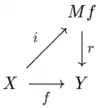Cofibration
In mathematics, in particular homotopy theory, a continuous mapping
- ,
where and are topological spaces, is a cofibration if it lets homotopy classes of maps be extended to homotopy classes of maps whenever a map can be extended to a map where , hence their associated homotopy classes are equal .
This type of structure can be encoded with the technical condition of having the homotopy extension property with respect to all spaces . This definition is dual to that of a fibration, which is required to satisfy the homotopy lifting property with respect to all spaces. This duality is informally referred to as Eckmann–Hilton duality. Because of the generality this technical condition is stated, it can be used in model categories.
Definition
Homotopy theory
A map of topological spaces is called a cofibration[1]pg 51 if for any map such that there is an extension to , meaning there is a map such that , we can extend a homotopy of maps to a homotopy of maps , where
We can encode this condition in the following commutative diagram
where is the path space of .
Cofibrant objects
For a model category , such as for pointed topological spaces, an object is called cofibrant if the map is a cofibration. Note that in the category of pointed topological spaces, the notion of cofibration coincides with the previous definition assuming the maps are pointed maps of topological spaces.
Examples
In topology
Cofibrations are an awkward class of maps from a computational perspective because they are more easily seen as a formal technical tool which enables one to "do" homotopy theoretic constructions with topological spaces. Fortunately, for any map
:
of topological spaces, there is an associated cofibration to a space called the mapping cylinder (where is a deformation retract of, hence homotopy equivalent to it) which has an induced cofibration called replacing a map with a cofibration
and a map through which factors through, meaning there is a commutative diagram
where is a homotopy equivalence.
In addition to this class of examples, there are
- A frequently used fact is that a cellular inclusion is a cofibration (so, for instance, if is a CW pair, then is a cofibration). This follows from the previous fact since is a cofibration for every , and pushouts are the gluing maps to the skeleton.
- Cofibrations are preserved under pushouts and composition, which is stated precisely below.
In chain complexes
If we let be the category of chain complexes which are in degrees , then there is a model category structure[2]pg 1.2 where the weak equivalences are quasi-isomorphisms, so maps of chain complexes which are isomorphisms after taking cohomology, fibrations are just epimorphisms, and cofibrations are given by maps
which are injective and the cokernel complex is a complex of projective objects in . In addition, the cofibrant objects are the complexes whose objects are all projective objects in .
Semi-simplicial sets
For the category of semi-simplicial sets[2]pg 1.3 (meaning there are no co-degeneracy maps going up in degree), there is a model category structure with fibrations given by Kan-fibrations, cofibrations injective maps, and weak equivalences given by weak equivalences after geometric realization.
Properties
- For Hausdorff spaces, every cofibration is a closed inclusion (injective with closed image); the result also generalizes to weak Hausdorff spaces.
- The pushout of a cofibration is a cofibration. That is, if is any (continuous) map (between compactly generated spaces), and is a cofibration, then the induced map is a cofibration.
- The mapping cylinder can be understood as the pushout of and the embedding (at one end of the unit interval) . That is, the mapping cylinder can be defined as . By the universal property of the pushout, is a cofibration precisely when a mapping cylinder can be constructed for every space X.
- Every map can be replaced by a cofibration via the mapping cylinder construction. That is, given an arbitrary (continuous) map (between compactly generated spaces), one defines the mapping cylinder
- .
- One then decomposes into the composite of a cofibration and a homotopy equivalence. That is, can be written as the map
- with , when is the inclusion, and on and on .
- There is a cofibration (A, X), if and only if there is a retraction from to , since this is the pushout and thus induces maps to every space sensible in the diagram.
- Similar equivalences can be stated for deformation-retract pairs, and for neighborhood deformation-retract pairs.
Constructions with cofibrations
Cofibrant replacement
Note that in a model category if is not a cofibration, then the mapping cylinder forms a cofibrant replacement. In fact, if we work in just the category of topological spaces, the cofibrant replacement for any map from a point to a space forms a cofibrant replacement.
Cofiber
For a cofibration we define the cofiber to be the induced quotient space . In general, for , the cofiber[1]pg 59 is defined as the quotient space
which is the mapping cone of . Homotopically, the cofiber acts as a homotopy cokernel of the map . In fact, for pointed topological spaces, the homotopy colimit of
In fact, the sequence of maps comes equipped with the cofiber sequence which acts like a distinguished triangle in triangulated categories.
See also
References
- May, J. Peter. (1999). A concise course in algebraic topology. Chicago: University of Chicago Press. ISBN 0-226-51182-0. OCLC 41266205.
- Quillen, Daniel G. (1967). Homotopical algebra. Berlin: Springer-Verlag. ISBN 978-3-540-03914-3. OCLC 294862881.
- Peter May, "A Concise Course in Algebraic Topology" : chapter 6 defines and discusses cofibrations, and they are used throughout
- Ronald Brown, "Topology and Groupoids" ; Chapter 7 is entitled "Cofibrations", and has many results not found elsewhere.

